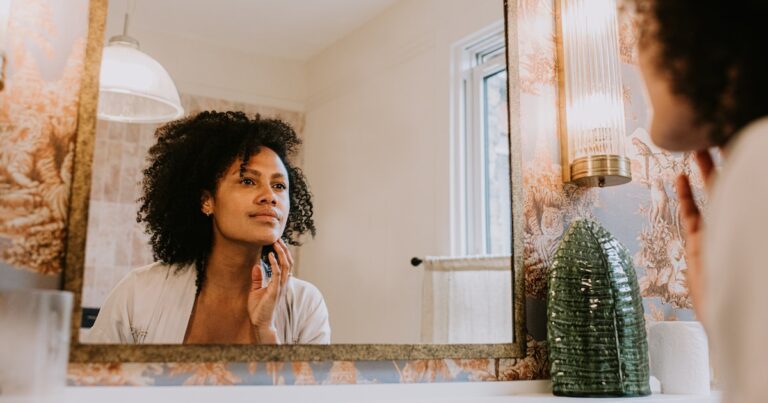
[ad_1]
I’ve always had an issue with the fine hair on my face, especially when the light hits it just so, and all of a sudden, I look a little like Teen Wolf. Well, maybe I’m exaggerating a tad, but regardless, it’s there — on my cheeks and chin mostly. If you can relate and have ever wondered what’s the deal (cue the Seinfeld voice) with those fine hairs located throughout most of your body, including your face, trunk, arms, and legs, then you might be interested in learning more about vellus hair. That’s the technical name for that “peach fuzz,” with vellus stemming from the Latin word that means “fleece” or “wool.”
Not surprisingly (given its name), the primary function of vellus hairs — like that of wool on sheep — is to “regulate body temperature by allowing your body to cool down by sweating or stay warm by providing insulation,” Dr. Morgana Colombo, MD, a board-certified dermatologist, tells Scary Mommy. “They also help with sensation by helping you sense light touch against your skin.”
Intrigued? Keep reading to learn more about this baby-fine layer of hair.
What is the difference between vellus hair and the other hair on our bodies?
You might’ve noticed the light hair on your arms has a different texture than the hairs on your head. That’s because they’re actually different types of hair.
“Vellus hairs are finer, softer, lighter, and shorter than terminal hairs, which tend to be coarser, thicker, darker, and grow longer,” Dr. Colombo explains. “Terminal hairs appear during puberty and are located in the scalp, pubic area, axillae, and face of men. Vellus hairs are present almost everywhere else in the body such as face, arms, legs, tops of fingers, toes, shoulders, back, chest.”
This hair may often appear under your armpits and private areas during puberty. It may become thicker, darker, and longer because of the increase in androgens. This hormone surge may also lead to the development of subcutaneous glands, which slick the hair with oil. This can also lead to acne.
The only areas on your body that don’t have vellus hairs are your palms, soles, and lips.
Another key difference between the two types of hair is that vellus hair is usually shorter than terminal hair. “However, in some cases, both hair types grow together,” Dr. Daniel Boyer of the Farr Institute tells Scary Mommy. “Terminal hair is the final hair formation of the body. It comprises the last few strands of hair grown by your skin.”
According to Dr. Boyer, terminal hair grows very fast, dividing every eight to 10 days. ‘This produces a lot of terminal hair that may be several inches long daily. Vellus hair is short, fine hair that grows on the edges of your eyelids and cheeks. It turns white in old age but doesn’t become terminal hair.”
What happens if you pluck vellus hair?
I don’t know about you, but I can get pretty obsessed with plucking my chin hairs, particularly one little sharp black one that keeps coming back no matter how hard I try to get rid of it. Thankfully, according to Dr. Colombo, my plucking won’t turn it into a long strand like the ones on my head.
“Plucking or shaving does not turn vellus hair into terminal hairs,” she says. “Plucked vellus hair eventually just regrows as vellus hair.”
Phew.
But as for that black hair? Well, that’s on me. “If you pluck vellus hair, it will become darker and harder,” Dr. Boyer says. “Plucking vellus hair pushes up the follicle that produces it into the skin. It will become darker and hardens as the follicle swells and thickens, eventually falling out on its own.”
What does it mean if you have a lot of vellus hair?
While some people genetically are predisposed to having more vellus hair, Dr. Colombo explains some conditions can lead to excessive vellus hair growth or what is known as hypertrichosis.
“Nutritional deficiencies such as in anorexia nervosa, use of certain medications such as cyclosporine, minoxidil or chemotherapeutic drugs, hormonal conditions such as Cushing’s syndrome, and underlying malignancy can all lead to increased growth of vellus hairs. Genetics also play a role, and certain populations are more predisposed to having excessive amounts of vellus hairs. If you experience sudden excessive growth of vellus hairs, that should be evaluated by a dermatologist or general doctor.”
What is a vellus hair cyst?
A vellus hair cyst is a reddish brown bump caused by a follicular development abnormality with vellus hair. They are usually seen on the chest, arms, and stomach area. Vellus hair cysts are most common in children, adolescents, and young adults. It’s important to never pop an ingrown hair cyst, as it can lead to infection or scarring.
This article was originally published on
[ad_2]